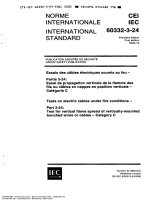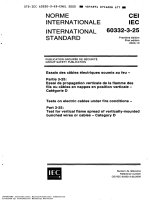Standard Method of Test for Slump Loss of Portland Cement Concrete ppsx
Bạn đang xem bản rút gọn của tài liệu. Xem và tải ngay bản đầy đủ của tài liệu tại đây (13.01 KB, 3 trang )
Standard Method of Test for
Slump Loss of Portland Cement Concrete
SCDOT Designation: SC-T-45 (09/09)
1. SCOPE
1.1. To determine the slump loss of freshly mixed Portland Cement Concrete over a
period of time.
1.2. This method is typically used for drilled shaft concrete. It may also be applicable in
special circumstances as deemed necessary by the RCE.
1.3. The purpose of this test is to ensure that drilled shaft concrete has a slump within the
range specified in Subsection 701.2.12.3 of the 2007 edition of SCDOT’s Standard
Specifications For Highway Construction when placed and maintains a minimum
slump as specified in Subsection 712.4.13.2 of the 2007 edition of SCDOT’s
Standard Specifications
For Highway Construction.
2. REFERENCED DOCUMENTS
ASTM C172 - Sampling Freshly Mixed Concrete
ASTM C143 - Slump of Hydraulic-Cement Concrete
ASTM C1064 -Temperature of Freshly Mixed Hydraulic-Cement Concrete
ASTM C231 - Air Content of Freshly Mixed Concrete by the Pressure Meter (if
required)
ASTM C31 - Making and Curing Test Specimens in the Field (if required)
3. PROCEDURE
3.1 Perform the test on concrete intended for use in the final product and meeting all
applicable SCDOT specifications.
3.2 Prepare the approved mix for the slump loss test at a temperature consistent with
ambient and concrete temperatures expected during actual concrete placement.
3.3 Ensure that the test batch is a minimum of 3 cubic yards.
3.4 After the test batch has been mixed according to Division 700 requirements, perform
initial slump (ASTM C143), ambient and concrete temperatures (ASTM C1064), and
if air entrained, air content (ASTM C231).
3.5 Part A In-Place Concrete
3.5.1 To simulate in-place plastic concrete, discharge approximately 1 cubic yard of
test batched concrete in a hole or form having approximate dimensions of 3 feet x 3
feet x 3 feet lined with plastic to prevent moisture loss through the ground or forms.
Have enough plastic to cover the top of the hole or form to prevent rapid evaporation.
3.5.2 Isolate the concrete from vibration for the duration of the test.
3.5.3 Obtain concrete from the simulated in-place concrete and perform slump
every hour until slump has reached the specified minimum in-place slump. Recover
the simulated in-place concrete with plastic after each slump test.
3.6 Part B Mixer Truck
3.6.1 Discharge approximately 1 cubic foot of test batch concrete and perform
slump, ambient and concrete temperature and air content (if air-entrained) every 30
minutes (
+
5 minutes) until slump has reached the minimum allowable level or the
designated time frame has expired (use 2 hours unless otherwise specified by the
RCE), whichever comes first.
3.6.2 After performing the initial tests, slowly agitate the mixer drum just prior to
performing the next set of tests. Mix the test batch concrete for at least one minute
at mixing speed.
4. REPORT
4.1. Record all results on SCDOT’s Slump Loss Report, OMR Form 712.1
Rev 9/4/09
Ready Mixed Plant
Date of Test
Contractor/Company and signatures of persons
SCDOT Witness:
Notes:
SCDOT OMR Form No. 712.1
South Carolina Department of Transportation
Slump Loss Report
Concrete
Temperature
Slump from
in-place
Time
Ambient
Temperature
% Air (if air
entrained)
Slump from
mixer truck
Class of Concrete
File Number
Project Number
performing tests:





![Standard Test Method for Compressive Strength of Hydraulic Cement Mortars (Using 2-in. or [50-mm] Cube Specimens)](https://media.store123doc.com/images/document/14/rc/yi/medium_yil1395845738.jpg)



